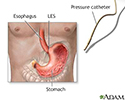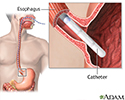Esophageal manometry
Esophageal motility studies; Esophageal function studies
Esophageal manometry is a test to measure how well the esophagus is working.
How the Test is Performed
During esophageal manometry, a thin, pressure-sensitive tube is passed through your nose, down the esophagus, and into your stomach.
Before the procedure, you receive numbing medicine inside the nose. This helps make the insertion of the tube less uncomfortable.
After the tube is in the stomach, the tube is pulled slowly back into your esophagus. At this time, you are asked to swallow. The pressure of the muscle contractions is measured along several sections of the tube.
While the tube is in place, other studies of your esophagus may be done. The tube is removed after the tests are completed. The test takes about 1 hour.
How to Prepare for the Test
You should not have anything to eat or drink for 8 hours before the test. If you have the test in the morning, DO NOT eat or drink after midnight.
Tell your health care provider about all medicines you are taking. These include vitamins, herbs, and other over-the-counter medicines and supplements.
How the Test will Feel
You may have a gagging sensation and discomfort when the tube passes through your nose and throat. You may also feel discomfort in your nose and throat during the test.
Why the Test is Performed
The esophagus is the tube that carries food from your mouth into the stomach. When you swallow, muscles in your esophagus squeeze (contract) to push food toward the stomach. Valves, or sphincters, inside the esophagus open to let food and liquid through. They then close to prevent food, fluids, and stomach acid from moving backward. The sphincter at the bottom of the esophagus is called the lower esophageal sphincter, or LES.
Esophageal manometry is done to see if the esophagus is contracting and relaxing properly. The test helps diagnose swallowing problems. During the test, the doctor can also check the LES to see if it opens and closes properly.
The test may be ordered if you have symptoms of:
- Heartburn or nausea after eating (gastroesophageal reflux disease, or GERD)
- Problems swallowing (feeling like food is stuck behind the breast bone)
Normal Results
The LES pressure and muscle contractions are normal when you swallow.
What Abnormal Results Mean
Abnormal results may indicate:
- A problem with the esophagus that affects its ability to move food toward the stomach (achalasia)
- A weak LES, which causes heartburn (GERD)
- Abnormal contractions of the esophagus muscles that do not effectively move food to the stomach (esophageal spasm)
Risks
Risks of this test include:
- Slight nosebleed
- Sore throat
- Hole, or perforation, in the esophagus (this rarely happens)
References
Pandolfino JE, Kahrilas PJ. Esophageal neuromuscular function and motility disorders. In: Feldman M, Friedman LS, Brandt LJ, eds. Sleisenger and Fordtran's Gastrointestinal and Liver Disease. 11th ed. Philadelphia, PA: Elsevier; 2021:chap 44.
Richter JE, Vaezi MF. Gastroesophageal reflux disease. In: Feldman M, Friedman LS, Brandt LJ, eds. Sleisenger and Fordtran's Gastrointestinal and Liver Disease. 11th ed. Philadelphia, PA: Elsevier; 2021:chap 46.
Review Date: 7/1/2021
Reviewed By: Michael M. Phillips, MD, Emeritus Professor of Medicine, The George Washington University School of Medicine, Washington, DC. Also reviewed by David Zieve, MD, MHA, Medical Director, Brenda Conaway, Editorial Director, and the A.D.A.M. Editorial team.




